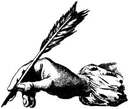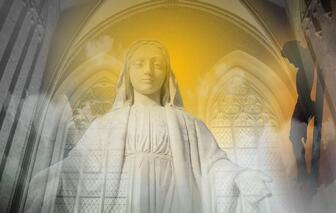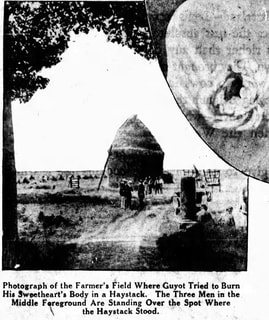 By M.P. Pellicer | Stranger Than Fiction Stories Two officers of the bicycle police brigade of Fresnes-sur-Marne were patrolling the road to Claye, when they came in the night upon a smoldering hayrick in a field belonging to Farmer Ernet. Under the rick about 100 feet off the main road and up a cart track, they smelled the odor of burning flesh. It was the body of a slender girl, and it was obvious by the charring of her body someone had set her on fire. 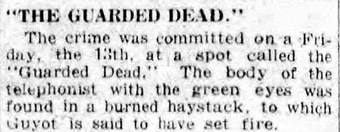 The spot where Marie Louise Beulaguet's body was found in the French countryside was known as "The Guarded Dead" c.1926 The spot where Marie Louise Beulaguet's body was found in the French countryside was known as "The Guarded Dead" c.1926 On August 13, 1926, a Friday, the police in the French city of Freses-sur-Marne were trying to solve what was dubbed by the press as the "Friday the 13th" murder. The body of a young girl was found in a burning haystack near a lonely road. The girl was strangled and the fire was assumed to have been started to conceal the crime. Ironically this spot where the body was discovered was called "The Guarded Dead". A man seen driving a red automobile that stopped at a roadside café on the Paris-Meaux highway, was believed to be the murderer. Initially the victim's name was not known, the only clue was a laundry mark on the partially burned clothing. She was well-dressed, and looked to be in her early twenties. The authorities discovered the girl had stopped at a nearby roadside diner. Madame Lambeau, the proprietress said the girl had told her a story in which a fortune teller had warned her that "something terrible" would happen to her on the 13th, but she laughed and said she wasn't worried. Her companion was man of about 45 years of age. They were traveling in a red brown Delage. Madame Lambeau described the girl as beautiful, with gray-green eyes and her hair bobbed in the latest style. She was gay and had even danced with her daughter. 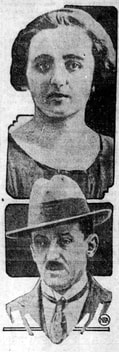 Gaston Guyot immediately came under suspicion for the murder of his young mistress nicknamed "Malou" c.1926 Gaston Guyot immediately came under suspicion for the murder of his young mistress nicknamed "Malou" c.1926 Less than a week later the identities of the man and the girl were established. The police were combing Paris for a wealthy broker named Gaston Guyot for the murder of Marie Louise Beulaguet nicknamed Malou, who was a Paris telephone operator. Guyot was a purported millionaire and the son of the mayor of Provins. Right away he was under suspicion for being a bluebeard and killing his two wives, each which had died suddenly after being stricken seriously while on auto trips with him in the mountains. He escaped police from his Paris apartment, leaving a letter to his 16-year-old daughter Madeleine and the concierge that he was innocent, and declaring he would commit suicide before being taken. He was captured on August 20, 1926 at Neaux, a suburb of Paris. The one-eyed fugitive, who used a glass eye due to an injury from the war, was caught leaving a hotel on the Boulevard Montparnasse after sending a letter to police that they would never capture him. He admitted to giving the girl a ride in his limousine, and was her companion at a roadside diner. 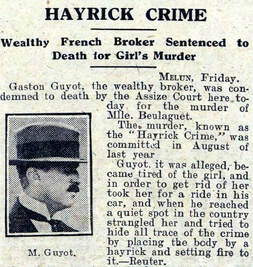 In France, the murder became known as the "Hayrick Crime" c.1926 In France, the murder became known as the "Hayrick Crime" c.1926 The police theorized he was planning to contract a rich marriage, and the girl stood in his way. She was 20 years old, and she had been his mistress for two years. He paid for her apartment at 99 Avenue du General Michel-Bizot. It was 3 doors away from his own home. The investigation into Malou’s murder had the Paris police take a closer look at the death of his two wives. In 1921, Guyot took his first wife Augusta to Candeville-le-Haut to visit her cousins, the Recouvreur. The story circulated at that time, was that she died after suddenly taking ill. The police spoke to Martin Recouvreur who said of his cousin's suicide: Guyot and Augusta occupied a room upstairs. We sleep on the first floor. In the evening before Augusta's death, Guyot and I had a a conversation, which has since impressed me. I met him in the courtyard near the well and he stopped me. 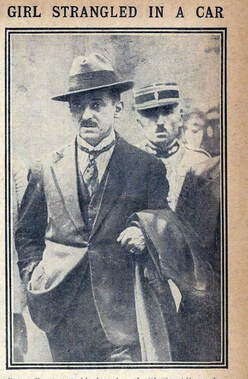 The murder investigation, noted that both of Guyot's wives had died under questionable circumstances c.1926 The murder investigation, noted that both of Guyot's wives had died under questionable circumstances c.1926 This term was used by the alienists of the day to describe a person with an exhausted central nervous system. Strangely even though Augusta Guyot was found with a bullet in her head, her cousins heard no shot, and attributed it to the thick walls of the farmhouse. He described how Guyot had appeared like a ghost at their bedroom door some time after midnight, and calmly announced: "What I feared has happened. Augusta has killed herself." The date was July 16, 1921. Martin Recouvreur told police, "I never had any suspicions of Guyot. The police doctor showed me how my cousin had probably lain in bed with the pistol hid under the clothes, waiting for her husband to sleep, so that she could kill herself without interference.” Augusta was the mother of his daughter, and within three years he married Georgette Barbichon, a widow, but she too died mysteriously only five months after the wedding. Again the story was she took sick during an auto trip while visiting the Cote d'Azur. After this he moved to Paris. He sent his daughter to an expensive boarding school, and part of the time she lived with her paternal grandfather in the provinces, however at the time of the investigation she had come to spend the holiday with her father. He declared to the magistrate that he had met Marie Louise in May, 1925 in Paris. She worked as a telephone operator. He would meet the young woman, who was only a few years older than his daughter every 15 days in Paris. He said she had a detestable character, and accused her of having other lovers in the country and in Paris. He explained that what precipitated the death of Malou was an argument. She told him that she had an offer of marriage and that if he didn't marry her, she would accept it. The dispute escalated, and then: ...at one time during the argument, which had become very violent, she slapped me several times, and I retaliated with a pretty stiff punch. Starting my car, I seized her by the throat, and squeezed it violently. She cried out like a pole cat, and all of a sudden fainted. I saw her stiff in my arms with her head leaning back, so I felt her pulse, and I found that her heart had ceased to beat. I again started my car and several miles farther on I saw in a field a large haystack. I drove my car near to it, and dragged the body of Marie Louise and placed it against the stack. I then threw a match into the hay. Then I hurried back to Paris. 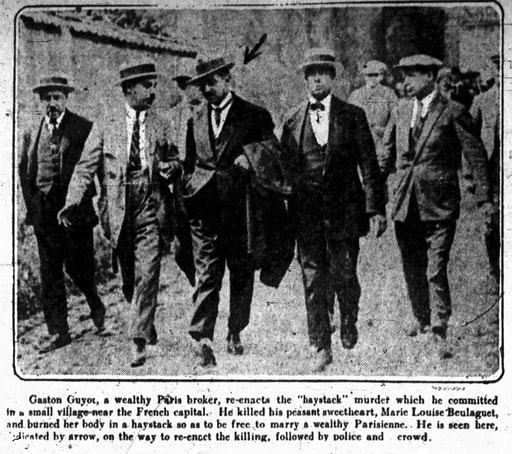 Eventually Guyot took the magistrate and officials to the scene of the crime and reenacted what happened c.1926 Eventually Guyot took the magistrate and officials to the scene of the crime and reenacted what happened c.1926 Later Guyot changed the reason for the argument, stating Malou was madly jealous of his daughter. She had been pressing him to marry her but he agreed only after his daughter Madeline had married. Later it was learned that Guyot's father, who turned him over to the police, believed he was innocent, but when he heard of his son's confession he was ashamed as he had reputation of being a lawful man. And this was only the beginning, since his son came under suspicion of committing many unsolved crimes besides this one. More information was given out about the death of his second wife. She had died in Monte Carlos, and he telegraphed her family to say she died of the influenza, but the Monaco authorities held an inquest at which the conclusion was reached that death was due to poison, probably self-administered. Members of her family declared that before starting on the trip, Guyot persuaded them to sign a paper relinquishing all claims to a share of his wife' estate in the event of any ill befalling her on the journey, in consideration of a sum of £200. The estate amounted to more than £2000. The Paris police decided to hold an official inquiry in connection with the death of the two wives of Gaston Guyot. It came to light that both of his wives were shot dead with a revolver, although none of the members of their families knew the truth of their deaths. Guyot told the parents of his first wife, she committed suicide. Ironically the revolvers used had been gifts Guyot had given each of them. 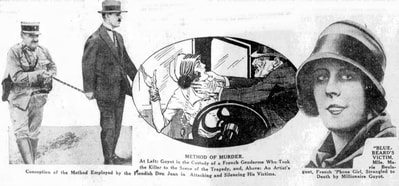 Reenactment of the crime in the French countryside, besides officials there were 1,500 onlookers. c.1926 Reenactment of the crime in the French countryside, besides officials there were 1,500 onlookers. c.1926 He told the parents of the second one that she died from influenza or a heart attack, when in truth she was found shot in a hotel at Monte Carlo, where owing to the authorities’ dislike for any publicity in cases of supposed suicide, it was easy for the husband to obtain a death certificate. Guyot told his friend she killed herself because she had lost a great deal of money at the casino gambling tables. Guyot was also charged with attempting to set fire to standing crops, an offense punishable in France with penal servitude for life. Later he denied this, saying he had just emptied his pipe, and the fire was accidental. Malou's body was exhumed and reexamined, and showed she had been subjected to considerable violence. Her nose and arms being badly bruised, and her throat fractured. The bodies of his former wives were also exhumed. The bad luck of killing his last victim on Friday the 13th grew exponentially when Guyot was being looked at for the mysterious death of a young girl, 15 years before at Trobin where his father lived. The girl was strangled at a time when Guyot was doing his military service there, and she had been raped. 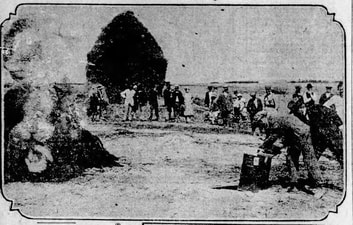 On August 28, 1926, Guyot went out to the countryside, 25 miles outside of Paris where he reenacted the scene that led to the death of Marie. There were 1,500 attendees, who brought picnic lunches to the spectacle. While the drama of this murder took place, Rudolph Valentino died unexpectedly in the United States, and the case was dropped from international headlines, but only for a few days. The authorities later learned that the relationship with Guyot and his mistress was a troubled one, and they argued often. He wrote a letter several months before, to a friend where he said, "Marie Louise can desert me if she likes, but I cannot desert her—you know why." The case of the second wife was especially engaging to the authorities, since in those years the statute of limitation had run out for the murder of his first wife. Georgette Guyot had died in February, 1925, and by then Malou was already his sweetheart. They wondered what was the secret that his mistress knew about him, where it seemed he feared to just cast her off, and had to resort to killing her. 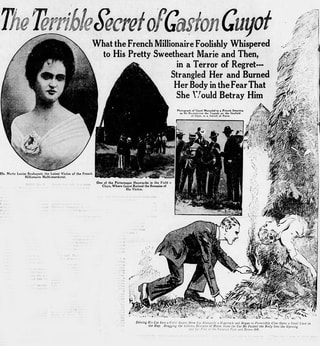 Some wondered if Guyot killed his mistress because she knew about his other crimes Some wondered if Guyot killed his mistress because she knew about his other crimes The bad luck of the 13th continued to haunt him, when by the end of September, 1926, M. Guyot was accused of the following crimes: 1. Murder of his two wives, which he explained as suicides; 2. Killing of a mail carrier on the highway by running over him with his auto and leaving the scene; 3. Assault and murder of a 15-year-old in the fields near his father's home at Louan, near Meaux; 4. Seduction of scores of young girls of peasant families, many who mysteriously disappeared and were acquaintances of his first wife; 5. Set fire to wheat crops; 6. Participation in the robbery of a million and a half francs from the Paris-Belfort express in February, 1926; 7. A railway robbery in 1921; 8. Dozens of cases of criminal arson. By November it became evident the Guyot was not in reality a successful speculator, and his lavish expenditures led him to ask aid from his parents on numerous occasions. It turned out that his debts exceeded one million francs. In July, 1921 a few weeks before the death of his first wife, a combination train, consisting of passengers and freight cars was held up 1 mile from Louan by a party of automobile bandits in concert with confederates, who had taken passage in the train. The robbery occurred on the one day of the month when the baggage car of this local train carried payroll sacks. The robbers took a half million francs, and it was theorized it was masterminded by someone familiar with local affairs. At the time the police followed without success a report that Guyot was seen to jump from the train 30 minutes after the robbery, when it had resumed its trip and was entering the station at Louan. In 1921, 1923, 1924 and 1925 the Louan Brigate investigated suspicious fires, which destroyed stored crops. Guyot was under suspicion as all the victims were clients of his Paris grain jobbing house. The local police believed that Guyot and his clients had set the fires for the purpose of recovering insurance. Over 10,000,000 francs were paid out to the insured. 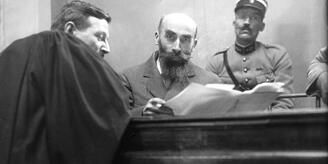 Henri Landru during his murder trial c.1921 Henri Landru during his murder trial c.1921 Guyot was being compared to Henri Désiré Landru (1869-1922) who had been called the Bluebeard of Gambais. Between December 1915 and January 1919 he killed at least seven women. He also killed three women and one of their sons in the house he rented from December 1914 to August 1915 in the town of Vernouillet. Authorities suspected he killed many more then were ever discovered. He seduced these women, convinced them to sign a power of attorney and then killed them. Afterwards he burned their bodies in his stove. Landru was guillotined just before dawn on February 25, 1922 outside the gates of the prison Saint-Pierre in Versailles. He was interred in the Les Gonards Cemetery in a grave marked only with a wooden cross and the name Henri Desire. Later his children changed their surname to Remy. Within two months Landru's grave became a regular stop on the sightseeing tours about Versailles. It started when a young American girl unpinned a bouquet from her corsage, and placed the violets on the mound. The French ridiculed the Americans for their morbidity. Then in April, 1922, Examining Magistrate Bonin who prepared the case against Landru died. It was reported that Landru predicted if he were guillotined, Bonin would die within three months. On Halloween, 1927, while the country was riveted with Guyot's murder trial, the lease on Landru's grave expired. Due to nonpayment the cross and hedge marking his resting place was removed. He was exhumed and reburied in another part of the cemetery where those who had been executed by guillotine were laid to rest, thus leaving him to an unnamed grave. 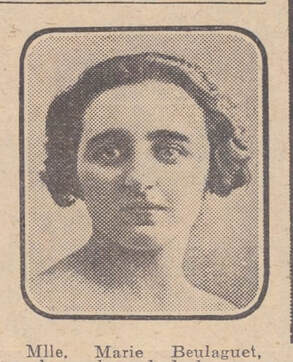 Marie Louise Beulaguet was given the moniker of "the girl with the green eyes" by the press Marie Louise Beulaguet was given the moniker of "the girl with the green eyes" by the press Guyot went to trial before the Melun Assize Court on a charge of murder in July, 1927. Doctors testified that Malou had not been dead when she was thrown into the hayrick and set on fire, as some fumes had been found in her lungs. This was later contradicted by another physician. Dr. Paul, a police doctor who had performed more than 34,000 autopsies challenged Guyot's description that he had strangled Malou with one hand, while he drove after they had quarreled. Dr. Hallouin who examined the girl's body with Dr. Paul determined she had not died within a few minutes, but only after a long struggle. Bruises on the arms, and other marks showed there was a face-to-face struggle, and that he had used both of his hands. She was killed while standing up, not sitting down. It was called an "affaire passionelle", even though Guyot was unfaithful to his own mistress with several women. Judge Sugier who presided over the trial asked him about the death of his two wives. Guyot said his first wife killed herself because she thought she had cancer, and his second because of her gambling losses. The judge responded, "Generally, when destiny commences to rain blows on a man it shows more ingenuity." 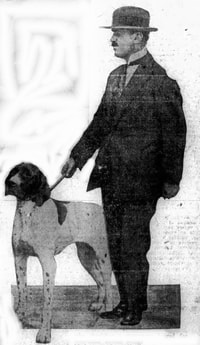 Guyot made the list of killers who did away with humans but were kind to animals Guyot made the list of killers who did away with humans but were kind to animals It came out during the trial that Guyot wanted to get rid of his mistress because he had plans to marry the sister of one of his two wives, who had money. His lack of funds always coincided with the so-called suicides of his wives, who with their deaths left him flush with money again. Guyot had not suffered in his upbringing. He was the son of a rich and respectable farmer who had inherited a small fortune from his mother. He moved to Paris and indulged in debauchery. While keeping Marie Louise as a mistress he carried on an affair with his own servant, and his brother's widow. He boasted of conquering hundreds of other women. By the time he was discovered as a cold-blooded killer he had spent his fortune of 2,000,000 francs. Guyot made the list of killers who were known to be kind to animals, when it became known he had showered his dogs with care and affection. 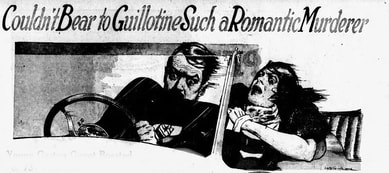 The American press ridiculed the fact that Guyot's sentence was commuted to life imprisonment because he was considered a romantic murderer. c.1927 The American press ridiculed the fact that Guyot's sentence was commuted to life imprisonment because he was considered a romantic murderer. c.1927 On July 22, 1927, Guyot was found guilty and sentenced to death. The courts awarded 50,000 francs to the mother of the murdered girl. The death sentence was appealed by his attorney. His appeal was denied in November, 1927. It wasn't until January 1928, that Guyot was given a reprieve when President Doumergue commuted his sentence to life imprisonment on Devil's Island. The American press made fun of the fact that he was considered a “romantic murderer” and due to this he escaped the guillotine. In those years, a sentence to this island prison in French Guinea was in effect a death sentence, but considered better than being beheaded in public. The prison opened in 1852, and was notorious for the harsh treatment of the guards and the diseases produced by the tropical climate. It had a death rate of 75%. Nothing more was ever heard of M. Guyot, and if he survived his stay in Devil’s Island. The prison closed in 1953.
0 Comments
Your comment will be posted after it is approved.
Leave a Reply. |
Stranger Than Fiction StoriesM.P. PellicerAuthor, Narrator and Producer Archives
July 2024
Categories
All
|
Stories of the Supernatural
- Stories of the Supernatural
- Miami Ghost Chronicles
- M.P. Pellicer | Author
- Stranger Than Fiction Stories
- Eerie News
- Supernatural Storytime
-
Astrology Today
- Tarot
- Horoscope
- Zodiac
-
Haunted Places
- Animal Hauntings
- Belleview Biltmore Hotel
- Bobby Mackey's Honky Tonk
- Brookdale Lodge
- Chacachacare Island
- Coral Castle
- Drayton Hall Plantation
- Jonathan Dickinson State Park
- Kreischer Mansion
- Miami Biltmore Hotel
- Miami Forgotten Properties
- Myrtles Plantation
- Pinewood Cemetery
- Rolling Hills Asylum
- St. Ann's Retreat
- Stranahan Cromartie House
- The Devil Tree
- Trans-Allegheny Lunatic Asylum
- West Virginia Penitentiary
- Paranormal Podcasts
"When misguided public opinion honors what is despicable and despises what is honorable, punishes virtue and rewards vice, encourages what is harmful and discourages what is useful, applauds falsehood and smothers truth under indifference or insult, a nation turns its back on progress and can be restored only by the terrible lessons of catastrophe."
- Frederic Bastiat
- Frederic Bastiat

Copyright © 2009-2024 Eleventh Hour LLC. All Rights Reserved ®
DISCLAIMER
DISCLAIMER
 RSS Feed
RSS Feed








